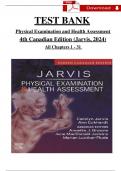lOMoAR cPSD| 8322407
TEST BANK
Physical Examination and Health Assessment
4th Canadian Edition (Jarvis, 2024)
All Chapters 1 - 31
, lOMoAR cPSD| 8322407
TABLE OF CONTENTS
, lOMoAR cPSD| 8322407
Chapter 1;
Critical Thinking and Evidence-Informed Assessment
MULTIPLE CHOICE
1. Which type of data is collected by obtaining vital signs?
a. Objective
b. Reflecting
c. Subjective
d. Introspective
ANSWER: a
Objective data are what the health professional observes
by inspecting, percussing, palpating, and auscultating
during the physical examination. Subjective data are what
the person says about themselves during history taking.
The terms reflective and introspective are not used to
describe data.
PTS: 1
DIF: Cognitive Level: Understanding (Comprehension)
MSC: Client Needs: Safe and Effective Care Environment: Management of
Care
2.During an assessment, a patient describes feeling
warm, nauseated, and nervous. Which type of data is
collected?
a. Objective
b. Reflective
c. Subjective
d. Introspective
ANSWER: c
, lOMoAR cPSD| 8322407
Subjective data are what the person says about themselves
during history taking. Objective data are whatthe health
professional observes by inspecting, percussing, palpating,
and auscultating during the physical examination. The
terms reflective and
, lOMoAR cPSD| 8322407
introspective are not used to describe data.
PTS: 1
DIF: Cognitive Level: Understanding (Comprehension)
MSC: Client Needs: Safe and Effective Care Environment: Management of
Care
3.Which part of a patient's health record is created when
combining laboratory studies, objective data, and
subjective data?
a. Database
b. Admitting data
c. Triage form
d. Discharge summary
ANSWER: a
Together with the patient's record and laboratory studies,
the objective and subjective data form the database. The
other items are not part of the patient's record, laboratory
studies, or data.
PTS: 1
DIF: Cognitive Level: Remembering (Knowledge)
MSC: Client Needs: Safe and Effective Care Environment: Management of
Care
4.Which action will the nurse complete if while listening
to a patient's breath sounds, they are unsure of a sound
heard?
a. Immediately notify the patient's most responsible
practitioner.
b. Document the sound exactly as it was heard.
c. Validate the data by asking a coworker to listen to the
breath sounds.
d. Assess again in 20 minutes to note whether the sound
is still present.
, lOMoAR cPSD| 8322407
ANSWER: c
When unsure of a sound heard while listening to a
patient's breath sounds, the nurse validates the data to
ensure accuracy. If the nurse has less experience in an
area, then they would ask an expert to listen.
PTS: 1
DIF: Cognitive Level: Analyzing (Analysis)
MSC: Client Needs: Safe and Effective Care Environment: Management of
Care
5.Which approach do novice nurses utilize when making
decisions?
a. Intuition
b. Clear-cut rules
c. Articles in journals
d. Advice from supervisors
ANSWER: b
Novice nurses operate from a set of defined, structured
rules. Expert practitioners use critical thinking and their
substantial background of experience.
PTS: 1
DIF: Cognitive Level: Understanding (Comprehension)MSC:
Client Needs: General
6. Which method moves a nurse from novice to expert?
a. Critical thinking
b. The nursing process
c. Clinical knowledge
d. Diagnostic reasoning
ANSWER: a
, lOMoAR cPSD| 8322407
Critical thinking is a multidimensional, dynamic, and
interactive thinking process by which expert nurses
assess and make decisions in the clinical area.
, lOMoAR cPSD| 8322407
PTS: 1
DIF: Cognitive Level: Understanding (Comprehension)MSC:
Client Needs: General
7.Which statement reflects the meaning of evidence-
informed practice (EIP)?
a. Best practice techniques to treat patients. Taking note
solely from Registered Nurses Association of Ontario
(RNAO)
b. Clinician experience and expertise to guide practice.
Sometimes reflecting on the patient perspective
c. Life-long problem-solving approach to clinical decision
making using best available evidence
d. The patient's own preferences are not important in EIP
ANSWER: c
EIP is more than the use of best practice techniques to
treat patients; it can be defined as a paradigm and
lifelong problem-solving approach to clinical decision
making that involves the conscientious use of the best
available evidence (including a systematic search for and
critical appraisal of the most relevant evidence to answer
a clinical question) with one's own clinical expertise and
patient values and preferences to improve outcomes for
individuals, groups, communities, and systems. EIP is
more than simply using the best practice techniques to
treat patients, and questioning tradition is important
when no compelling and supportive research evidence
exists.
PTS: 1
DIF: Cognitive Level: Applying (Application)
MSC: Client Needs: Safe and Effective Care Environment: Management of
Care
8. Which example illustrates a first-level priority problem?
, lOMoAR cPSD| 8322407
a. Postoperative pain
b. Newly diagnosed diabetes needing diabetic teaching
c. Small laceration on the sole of the foot
d. Shortness of breath and respiratory distress
ANSWER: d
First-level priority problems are those that are emergent,
life-threatening, and immediate (e.g., establishing an
airway, supporting breathing, maintaining circulation,
monitoring abnormal vital signs) (see Table 1.1 –
Identifying Immediate Priorities).
PTS: 1
DIF: Cognitive Level: Understanding (Comprehension)
MSC: Client Needs: Safe and Effective Care Environment: Management of
Care
Which critical thinking skill recognizes relationships
9.
among the data?
a. Validation
b. Clustering related cues
c. Identifying gaps in data
d. Distinguishing relevant data from irrelevant data
ANSWER: b
Clustering related cues helps the nurse see relationships
among the data.
PTS: 1
DIF: Cognitive Level: Understanding (Comprehension)
MSC: Client Needs: Safe and Effective Care Environment: Management of
Care
10.Which diagnosis is critical to develop appropriate
nursing interventions for a patient?
a. Nursing
b. Medical
, lOMoAR cPSD| 8322407
c. Admission




